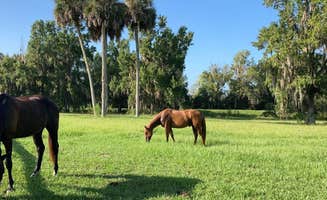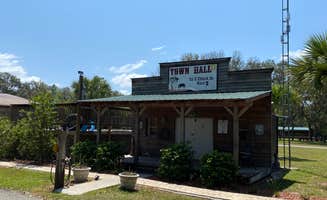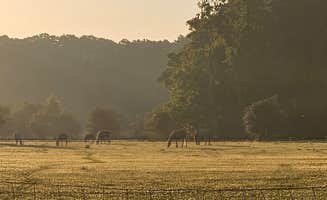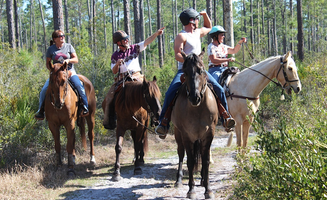Equestrian camping near Gainesville, Florida offers diverse terrain spanning from pine forests to wetland prairies. The area maintains a subtropical climate with temperatures averaging 85°F in summer months and 65°F in winter, making year-round camping feasible. Most horse-friendly campgrounds in the region provide access to trail systems that connect through protected conservation areas where wildlife viewing opportunities are common.
What to do
Wildlife viewing excursions: At Paynes Prairie Preserve State Park Campground, campers can observe diverse species along eight designated trails. "This park has 8 trails for hiking, biking and horseback riding. We were able to see wild horses, bisons, snakes and gators. Great for fishing and kayaking," notes Brenda S. The park maintains observation platforms strategically positioned for wildlife spotting.
Mountain biking adventures: The Santos Trailhead & Campground offers internationally recognized mountain biking trails with manufactured features. "It's an international destination for mountain biking! While there are no mountains in Florida, there are many man made ramps and jumps and turns. It's remarkable to see," explains David G. The trail system includes over 30 miles of routes categorized by difficulty level.
Horseback riding tours: Multiple trail networks connect between campgrounds in the area, particularly along the Cross Florida Greenway system. "The surrounding trail system allows riders to observe native wildlife including alligators, various bird species," with trails rated for various experience levels from beginner to advanced. Seasonal guided rides are available through local outfitters.
What campers like
Clean facilities: Campgrounds maintain regular cleaning schedules for restrooms and shower facilities. "Bathrooms are clean. Plenty of hiking to be found. Buffalo, deer, eagles, alligators, owls," reports Jenn B. about her experience at Paynes Prairie Preserve State Park Campground.
Shaded campsites: Many campgrounds feature oak canopy coverage providing natural temperature regulation. "The sites are spacious and most are shaded. We stayed in site #3, which was tucked into the wood line and somewhat private," shares Rich S. about his stay at Santos Trailhead Campground. Site selection impacts shade availability, with summer temperatures making this a priority consideration.
Diverse trail access: O'Leno State Park provides direct trail connections from campsites. "There are several trails available for hiking and biking and a primitive campsite on Sweetwater Trail. Santa Fe River goes underground in this area and you can check it out along the trails, going in and coming out again," explains Shelly S. Trail maps are available at park offices.
What you should know
Mosquito presence: Florida's humid climate supports significant mosquito populations, particularly in wetland areas. "Hot with skeeters the majority of the year, cold overnight in the winter. All kinds of little critters in the woods and access to hikes and many gators," warns Dan X. about Paynes Prairie Preserve State Park Campground. Long sleeves and insect repellent are recommended, especially during dawn and dusk hours.
Seasonal flooding: Low-lying areas experience periodic water level changes affecting trail accessibility. "The swimming area (WHAT!!) was closed when we visited due to high water levels," reports Shelly S. about O'Leno State Park. Water levels are typically highest during summer rainy season (June-September).
Limited cell service: Many campgrounds experience spotty connectivity due to rural locations. "Poor/spotty cell service in park, but there's free wifi at the concession stand," notes Laura M. about Manatee Springs State Park. Campground offices often post daily weather forecasts for those without reliable connectivity.
Tips for camping with families
Kid-friendly water features: Springs maintain consistent temperatures year-round for swimming. "Lovely Park with lots of wildlife!! La Chua trail was beautiful and we saw lots of gators. We did the Ranger led hike which was really nice, my 5 year old struggled to keep up with the Ranger and there are decent elevation changes," advises Lindsey H. from her visit to Paynes Prairie Preserve State Park Campground.
Educational programming: Ranger-led programs provide structured learning opportunities for children. "The facilities are very clean and staff are courteous, grounds are well-kept and events (like baby alligator educational sessions) are above-par," notes Kristin T. about Paynes Prairie. Program schedules are posted at visitor centers and typically run weekends during peak seasons.
Dog restrictions on trails: Ross Prairie Campground allows pets but with access limitations to certain areas. "The biggest disappointment for this state park is that all of the things they advertise (and I was looking forward to) - bison, horses, wildlife - are all on trails where pets are not allowed," cautions Denise about regional parks. Pet-friendly trails are clearly marked on maps available at entrance stations.
Tips from RVers
Electrical service variability: Campgrounds offer different amperage options with limited availability of higher-powered sites. "All sites are pull thru for you RVers out there! Definitely quieter here," notes Bran P. about Ross Prairie Campground. Reservation systems typically allow filtering by electrical service requirements.
Site terrain considerations: Sandy soil presents challenges for leveling and stability. "Campsites have fire ring and picnic tables. Sites have fire ring and picnic tables," notes Dave D. about Manatee Springs State Park. Wooden blocks or specialized levelers are recommended for stabilizing RVs on sandy terrain.
Off-season advantages: Lower occupancy during summer months provides more site options and privacy. "Only here two days. Nice little quick stop," mentions Karen about Ross Prairie Campground. Summer heat reduces visitor numbers despite being the traditional vacation season.






